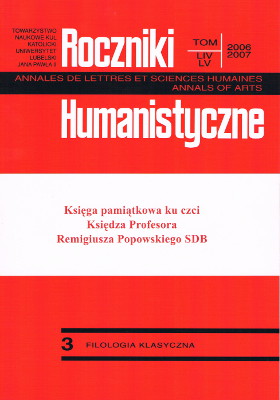Presentation of Statues (Andriantopoiika) in the New Posidippus
Abstract
Posidippus’ Andriantopoiika (epigrams 62-70 Austin-Bastianini), in accordance with their subject heading, deal with statue-making. Nearly every epigram contains phrases alluding to sculpting. One of the poet’s chief concerns was to show the criteria of the perfect art. The section begins with a direct appeal to sculptors to imitate ‘these works’ (probably those presented by Posidippus in the cluster that follows) and to leave aside ‘ancient rules for larger-than-lifesize statues’. In one poem (63) the poet proclaims a ‘canon of truth’, i.e. of realism, as the desirable style of sculpture. Miniaturism and polish are also highly valued. Although Posidippus praises other masters too — including older ones — the precedence is given to Lysippus, the favourite sculptor of Alexander whose presumed lawful successors were the Ptolemies. The section as a whole certainly gives a valuable clue to the principles of Hellenistic art.
Most of these poems can be classified as ekphrastic. Their form and underlying conception prove that Posidippus had an ambition to create a varied type of ekphrasis, in its content considerably independent of the described work of art. In the Andriantopoiika, the poet inserts, among other things, a historical comment (68), an anecdote (66), and literary allusions (64). His formal addressees include the spectator (64, 67), the artist who created a given work of art (65), and even the work or its elements themselves (64). However, it is always the reader who remains the intended addressee of each poem. The poet neither simply presents the sculptures nor states the plain facts connected with them. His epigrams serve specific ideological purposes, as they promote the cultural policy of the Ptolemies, consciously adopting the aesthetic preferences of Alexander.
References
Angiò F.: Posidippo di Pella, P. Mil. Vogl. VIII 309 – col. XI, ll. 1-5 e Plinio il Vecchio (Nat. Hist. XXXIV 83), „Analecta Papyrologica” 13 (2001), s. 91-101.
Angiò F.: Filita di Cos in bronzo (Ermesianatte, fr. 7, 75-78 Powell-P. Mil. Vogl. 309, col. X, ll. 16-25), „Archiv für Papyrusforschung” 48 (2002), s. 17-24 [63 AB].
Angiò F.: Artisti «vecchi» e «nuovi» (Posidippo di Pella, P. Mil. Vogl. VIII 309, col. X 8-15, „Museum Helveticum” 61 (2004), s. 65-71 [62 AB].
BernardiniP., Bravi L.: Note di lettura al nuovo Posidippo, „Quaderni Urbinati di cultura classica” N.S. 70 (2002), s. 147-163.
Chinn C.: Statius Silv. 4.6 and the Epigrammatic Origins of Ekphrasis, „Classical Philology” 100 (2005), s. 247-263.
Danielewicz J.: Posejdippos. Epigramy. Przełożył, wstępem i komentarzem opatrzył ..., Warszawa: Prószyński i S-ka 2004. Seria „Biblioteka Antyczna”.
Esposito E.: Posidippo, Eronda e l’arte tolemaica, [w:] Posidippo e gli altri. Il poeta, il genere, il contesto culturale e letterario. Atti dell’ incontro di studio, Roma, 14-15 maggio 2004, a cura di M. Di Marco, B. M. Palumbo, E. Lelli, Pisa–Roma: Istituti Editoriali e Poligrafici Internazionali 2005, s. 191-202. Appunti Romani di Filologia VI.
Falivene M. R.: Esercici di EKPHRASIS: delle opposte fortune di Posidippo e Callimaco, [w:] Il papiro di Posidippo un anno dopo, a cura di G. Bastianini e A. Casanova, Firenze: Istituto papirologico G. Vitelli 2002, s. 33-40.
Gutzwiller K.: Posidippus on Statuary, [w:] Il papiro di Posidippo un anno dopo, a cura di G. Bastianini e A. Casanova, Firenze: Istituto papirologico G. Vitelli 2002, s. 41-60.
Gutzwiller K.: The Literariness of the Milan Papyrus, or ‘What Difference a Book?’, [w:] The New Posidippus. A Hellenistic Poetry Book, ed. K. Gutzwiller, Oxford: Oxford University Press 2005, s. 287-319.
Hardie A.: The Statue(s) of Philitas (P. Mil. Vogl. VIII 309 Col. X.16-25 and Hermesianax fr. 7.75-78 P.), „Zeitschrift für Papyrologie und Epigraphik” 143 (2003), s. 27-36.
Kosmetatou E.: Vision and Visibility: Art Historical Theory Paints a Portrait of New Leadership in Posidippus’ Andriantopoiika, [w:] Labored in Papyrus Leaves: Perspectives on an Epigram Collection Attributed to Posidippus (P. Mil. Vogl. VIII 309), edd. B. Acosta-Hughes, E. Kosmetatou, M. Baumbach, Washington: Center for Hellenic Studies 2004, s. 187-211. Hellenic Studies 2.
Kosmetatou E., Papalexandro u N.: Size Matters: Poseidippos and the Colossi, „Zeitschrift für Papyrologie und Epigraphik” 143 (2003), s. 53-58.
Krieger M.: Das Problem der Ekphrasis: Wort und Bild, Raum und Zeit – und das literarische Werk, [w:] Beschreibungskunst – Kunstbeschreibung. Ekphrasis von der Antike bis zur Gegenwart, hrsg von G. Boehm, H. Pfotenhauer, München: Fink 1995, s. 41-57.
Lelli E.: I gioielli di Posidippo, „Quaderni Urbinati di cultura classica” N.S. 70 (2004), s. 127-137 (Addendum 138).
Sens A.: The Art of Poetry and the Poetry of Art: The Unity and Poetics of Posidippus’ Statue-Poems, [w:] The New Posidippus. A Hellenistic Poetry Book, ed. K. Gutzwiller, Oxford: Oxford University Press 2005, s. 206-225.
Stewart A.: Posidippus and the Truth in Sculpture, [w:] The New Posidippus. A Hellenistic Poetry Book, ed. K. Gutzwiller, Oxford: Oxford University Press 2005, s. 183-205.
Zanker G.: New Light on the Literary Category of ‘Ekphrasis Epigram’ in Antiquity: the New Posidippus (col. X 7 – XI 19 P. Mil. Vogl. VIII 309), „Zeitschrift für Papyrologie und Epigraphik” 143 (2003), s. 59-62.
Copyright (c) 2007 Roczniki Humanistyczne

This work is licensed under a Creative Commons Attribution-NonCommercial-NoDerivatives 4.0 International License.





